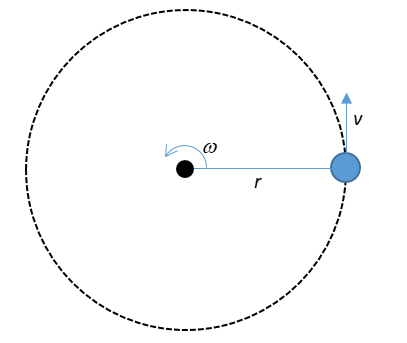
A body moves with constant angular velocity on a circle. Magnitude of angular acceleration.
A. \[r{\omega ^2}\]
B. Constant
C. Zero
D. None of the above
Answer
217.2k+ views
Hint:The rate of change of angular velocity is called angular acceleration. When a body is moving in a circular path with constant speed than at every point the direction of linear velocity changes.
Formula used:
\[v = \omega r\]
where v is the linear velocity, \[\omega \] is the angular velocity and r is the distance of the point from the axis of rotation.
\[\alpha = \dfrac{{d\omega }}{{dt}}\]
Here \[\alpha \] is the angular acceleration of the particle and \[\dfrac{{d\omega }}{{dt}}\] is the rate of change of angular velocity.
Complete step by step solution:
When a body is moving in a circular path then the position of the body along the circular path changes with time. As we know, the rate of change of the linear position of the body with respect to time is called linear velocity. The rate of change of the angular position with respect to time is called the angular velocity.
It is given that the particle is moving in a circular path with constant angular velocity. Let at any time \[{t_1}\]the angular velocity is \[{\omega _1}\]. Then at any other time \[{t_2}\]the angular velocity is \[{\omega _2}\]. We need to find the angular acceleration of a particle on a circular path.

Image: Particle’s uniform circular motion
Let the angular acceleration of the body is \[\alpha \]. The distance of the body from the axis of rotation, i.e. from the center of the circular path is equal to the radius of the circular path. Using the formula for angular acceleration,
\[\alpha = \dfrac{{{\omega _2} - {\omega _1}}}{{{t_2} - {t_1}}}\]
As the angular velocity is constant \[{\omega _1} = {\omega _2}\]
\[\alpha = \dfrac{{\omega - \omega }}{{{t_2} - {t_1}}}\]
\[\Rightarrow \alpha = \dfrac{0}{{{t_2} - {t_1}}}\]
\[\therefore \alpha = 0\,rad/{s^2}\]
Hence, the angular acceleration of the body is equal to zero.
Therefore, the correct option is C.
Note: We should be careful while using the relation between the linear velocity and the angular velocity as it is for the instantaneous velocity. So, if we find the linear velocity of the accelerated body in a circular path then the obtained linear velocity will be corresponding to the angular velocity at that instant in time.
Formula used:
\[v = \omega r\]
where v is the linear velocity, \[\omega \] is the angular velocity and r is the distance of the point from the axis of rotation.
\[\alpha = \dfrac{{d\omega }}{{dt}}\]
Here \[\alpha \] is the angular acceleration of the particle and \[\dfrac{{d\omega }}{{dt}}\] is the rate of change of angular velocity.
Complete step by step solution:
When a body is moving in a circular path then the position of the body along the circular path changes with time. As we know, the rate of change of the linear position of the body with respect to time is called linear velocity. The rate of change of the angular position with respect to time is called the angular velocity.
It is given that the particle is moving in a circular path with constant angular velocity. Let at any time \[{t_1}\]the angular velocity is \[{\omega _1}\]. Then at any other time \[{t_2}\]the angular velocity is \[{\omega _2}\]. We need to find the angular acceleration of a particle on a circular path.

Image: Particle’s uniform circular motion
Let the angular acceleration of the body is \[\alpha \]. The distance of the body from the axis of rotation, i.e. from the center of the circular path is equal to the radius of the circular path. Using the formula for angular acceleration,
\[\alpha = \dfrac{{{\omega _2} - {\omega _1}}}{{{t_2} - {t_1}}}\]
As the angular velocity is constant \[{\omega _1} = {\omega _2}\]
\[\alpha = \dfrac{{\omega - \omega }}{{{t_2} - {t_1}}}\]
\[\Rightarrow \alpha = \dfrac{0}{{{t_2} - {t_1}}}\]
\[\therefore \alpha = 0\,rad/{s^2}\]
Hence, the angular acceleration of the body is equal to zero.
Therefore, the correct option is C.
Note: We should be careful while using the relation between the linear velocity and the angular velocity as it is for the instantaneous velocity. So, if we find the linear velocity of the accelerated body in a circular path then the obtained linear velocity will be corresponding to the angular velocity at that instant in time.
Recently Updated Pages
Differential Equations Explained: Guide for Students

Functional Equations Explained: Key Concepts & Practice

Graphical Methods of Vector Addition Explained Simply

Introduction to Dimensions: Understanding the Basics

[Awaiting the three content sources: Ask AI Response, Competitor 1 Content, and Competitor 2 Content. Please provide those to continue with the analysis and optimization.]

JEE Atomic Structure and Chemical Bonding important Concepts and Tips

Trending doubts
JEE Main 2026: Application Form Open, Exam Dates, Syllabus, Eligibility & Question Papers

Derivation of Equation of Trajectory Explained for Students

Hybridisation in Chemistry – Concept, Types & Applications

Understanding the Angle of Deviation in a Prism

Understanding Collisions: Types and Examples for Students

How to Convert a Galvanometer into an Ammeter or Voltmeter

Other Pages
JEE Advanced Marks vs Ranks 2025: Understanding Category-wise Qualifying Marks and Previous Year Cut-offs

Units And Measurements Class 11 Physics Chapter 1 CBSE Notes - 2025-26

NCERT Solutions For Class 11 Physics Chapter 8 Mechanical Properties Of Solids

Motion in a Straight Line Class 11 Physics Chapter 2 CBSE Notes - 2025-26

NCERT Solutions for Class 11 Physics Chapter 7 Gravitation 2025-26

Understanding Atomic Structure for Beginners




